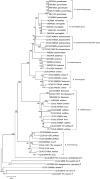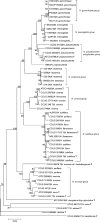A genomic approach to bacterial taxonomy: an examination and proposed reclassification of species within the genus Neisseria
- PMID: 22422752
- PMCID: PMC3541776
- DOI: 10.1099/mic.0.056077-0
A genomic approach to bacterial taxonomy: an examination and proposed reclassification of species within the genus Neisseria
Abstract
In common with other bacterial taxa, members of the genus Neisseria are classified using a range of phenotypic and biochemical approaches, which are not entirely satisfactory in assigning isolates to species groups. Recently, there has been increasing interest in using nucleotide sequences for bacterial typing and taxonomy, but to date, no broadly accepted alternative to conventional methods is available. Here, the taxonomic relationships of 55 representative members of the genus Neisseria have been analysed using whole-genome sequence data. As genetic material belonging to the accessory genome is widely shared among different taxa but not present in all isolates, this analysis indexed nucleotide sequence variation within sets of genes, specifically protein-coding genes that were present and directly comparable in all isolates. Variation in these genes identified seven species groups, which were robust to the choice of genes and phylogenetic clustering methods used. The groupings were largely, but not completely, congruent with current species designations, with some minor changes in nomenclature and the reassignment of a few isolates necessary. In particular, these data showed that isolates classified as Neisseria polysaccharea are polyphyletic and probably include more than one taxonomically distinct organism. The seven groups could be reliably and rapidly generated with sequence variation within the 53 ribosomal protein subunit (rps) genes, further demonstrating that ribosomal multilocus sequence typing (rMLST) is a practicable and powerful means of characterizing bacteria at all levels, from domain to strain.
Figures



Comment in
-
Two novel methods for using genome sequences to infer taxonomy.Microbiology (Reading). 2012 Jun;158(Pt 6):1414. doi: 10.1099/mic.0.059816-0. Epub 2012 Apr 13. Microbiology (Reading). 2012. PMID: 22504434 No abstract available.
References
-
- Achtman M., Wagner M. (2008). Microbial diversity and the genetic nature of microbial species. Nat Rev Microbiol 6, 431–440. - PubMed
Publication types
MeSH terms
Grants and funding
LinkOut - more resources
Full Text Sources
Other Literature Sources
Molecular Biology Databases
Research Materials

